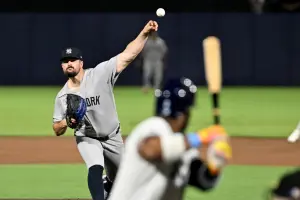
(*) F/F SPOTLIGHT: Julio Teheran
An elite minor league arm—and arguably the top pitching prospect in baseball entering 2012—Julio Teheran (RHP, ATL) quickly lived up to the hype with a 3.03 ERA over his first two full MLB seasons. After hitting a speed bump in year three (4.04 ERA in 2015), Teheran has quickly recovered in 2016 and has been a bright spot on an otherwise depleted ATL roster. At just 25, Teheran figures to be an integral part of ATL's rebuild, but have we already seen the best he has to offer?
Let’s dive right in to Teheran’s performance; first, in traditional Facts/Flukes style:
Year IP ERA xERA Ctl Dom Cmd FpK SwK GB/LD/FB H%/S% Ball% OPSvL BPV ==== === ==== ==== === === === === === ======== ===== ===== ===== === 2013 186 3.20 3.67 2.2 8.2 3.8 65% 11% 38/21/41 30/78 33.3% .823 105 2014 221 2.89 3.73 2.1 7.6 3.6 60% 11% 35/21/44 28/77 33.9% .687 93 2015 201 4.04 4.15 3.3 7.7 2.3 57% 11% 40/24/36 29/73 37.0% .893 68 2016 130 2.71 3.73 1.9 8.0 4.1 62% 11% 40/18/41 24/79 34.6% .668 109
An initial skill scan shows that Teheran has improved, but he's outpitched his peripherals:
- A full run gap between ERA and xERA jumps out right away. Teheran’s benefited from some fortunate luck throughout his career, but never quite to this degree.
- Teheran’s missing bats at a solid rate (SwK), though his Dom remains near league average. Cmd has surged thanks to a sharp decrease in walks from 2015, while his first-pitch strike rate (FpK) and Ball% suggest he'll continue to be stingy with the free pass.
- Production against left-handed hitters has seesawed throughout his career, with 2016 being a particularly solid showing against lefties.
Teheran has shown some growth in his fourth full MLB season, mostly in part to improved Ctl, which has returned to 2013-14 levels. However, good fortune looks to be at play here as well. We’ll dive a bit deeper into Teheran’s profile to see 1) if his pitch mix supports further growth, 2) what’s driving his recent fortune, and 3) if Teheran can hold 2016's gains against left-handed hitters.
In the hunt? BaseballHQ.com can help you snag the title. Unlock all of our insights like these for the rest of the season: Subscribe to BaseballHQ.com.
Pitch mix
Teheran’s pitch mix, shown below (from BrooksBaseball.net), shows he’s mostly relied on a fastball / slider combination throughout his career; with a small sampling of curveballs and changeups mixed in:
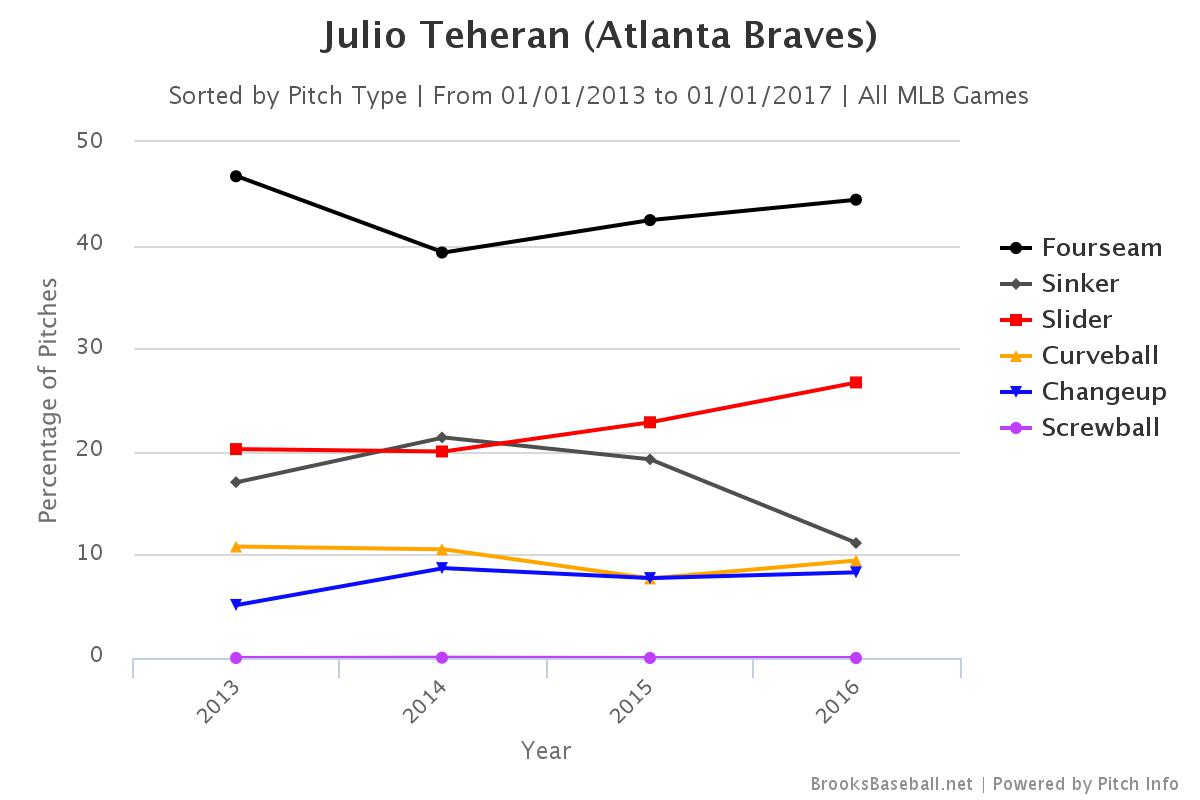
We'll dive deeper into few of Teheran’s pitches, starting with the slider:
Slider
Year Usage SwK O-Swing% ==== ===== === ======== 2013 20% 17% 35.7% 2014 20% 19% 41.5% 2015 23% 23% 42.3% 2016 27% 27% 47.9%
By far Teheran’s best strikeout pitch, the slider has increasingly missed bats and he continues to throw it more often. Hitters are swinging at the slider outside the zone nearly half the time (O-Swing%), which fits his approach with the pitch perfectly. Here's a zone plot (from the catcher's POV) on Teheran’s slider throughout his career:
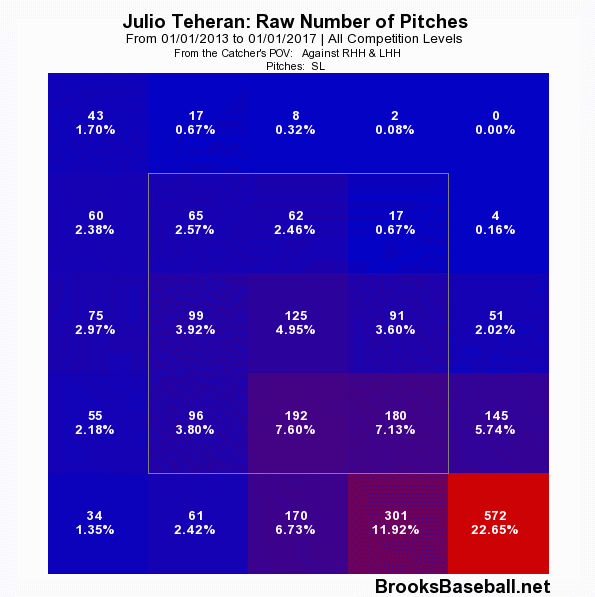
Teheran's slider placement has been consistent against both lefties and righties as well. Against RHB, Teheran's slider starts in the zone and darts low and away (video from BaseballSavant.MLB.com):
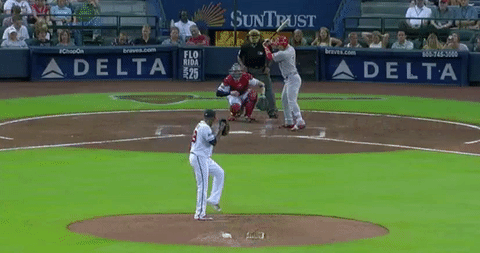
And it's equally effective against lefties, where it jumps low and in:
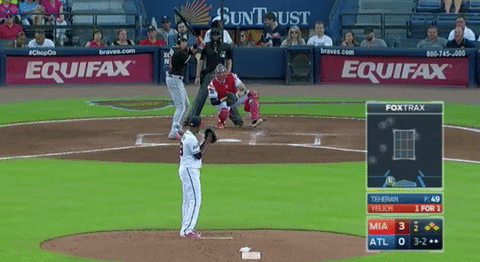
Teheran’s ability to generate whiffs on the slider and consistently place it in a hard-to-hit spot give it plenty of staying power going forward, and it’s paramount to Teheran maintaining a league-average strikeout rate.
Four-seam fastball
Year Usage GB/LD/FB SwK Contact% ==== ===== ======== ===== ======== 2013 47% 35/25/41 10.0% 80.7% 2014 39% 44/24/32 9.5% 81.2% 2015 42% 40/28/32 8.8% 80.0% 2016 44% 33/33/33 6.9% 85.2%
Teheran has relied heavily on his four-seam fastball, throwing it over 40% of the time. A few issues are surfacing, however:
- Teheran has consistently given up a ton of line drives off the fastball—hitters seem to be squaring it up with ease.
- Contact% (percentage of times a batter makes contact when he swings) has spiked in 2015. Not surprisingly, his SwK is in a downward spiral.
- Perhaps related to the second bullet, Teheran’s four-seam velocity has declined throughout his MLB career:
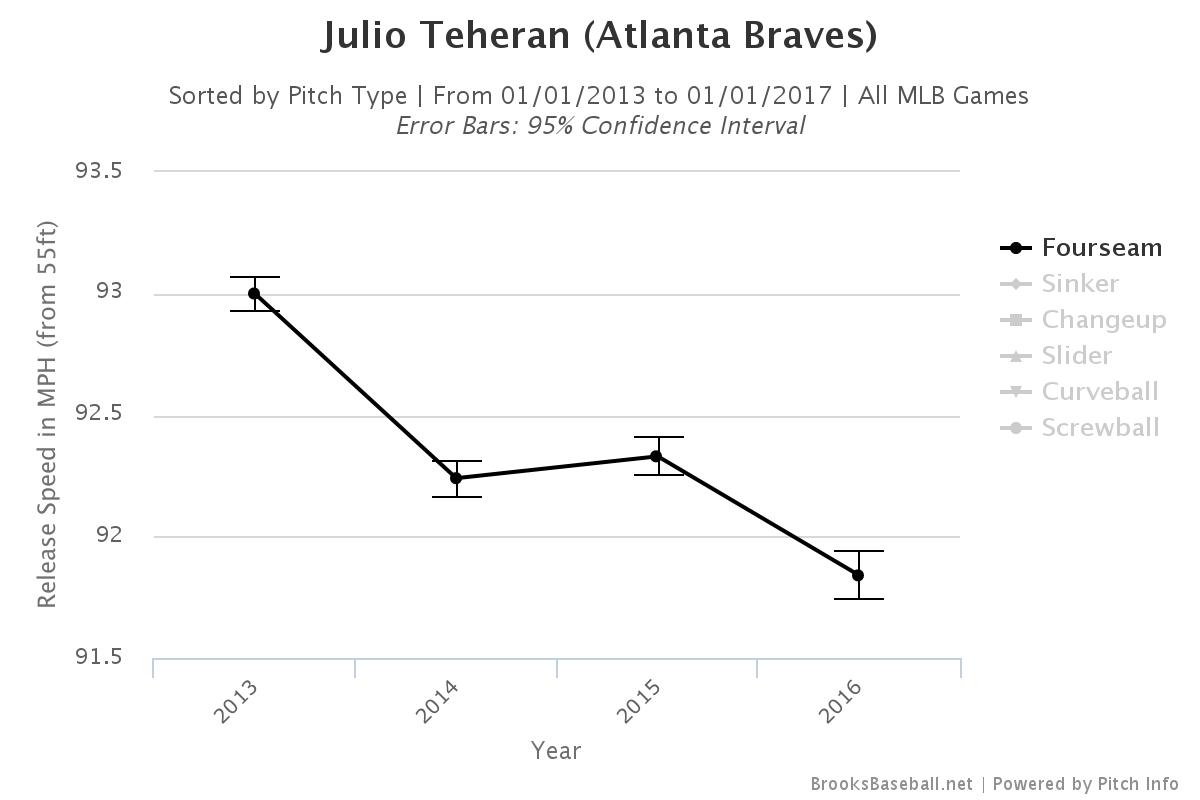
The average SwK on four-seamers is roughly 6%, so Teheran's still in decent shape for now. But the downward trend in SwK and velocity with a heavy dose of line drives suggest Teheran's fastball hasn't been the asset it was early in his career.
Sinker / two-seam fastball
Year Usage GB/LD/FB SwK Contact% ==== ===== ======== ==== ======== 2013 17% 56/23/21 5.0% 90.6% 2014 21% 44/24/32 6.2% 86.3% 2015 19% 48/32/19 4.0% 90.7% 2016 11% 58/18/23 1.9% 95.5%
Teheran's two-seamer was never designed to be a swing-and-miss pitch, but hitters are now making contact with it nearly every time (Contact%), and they’re rarely swinging at strikes.
Teheran has veered away from the two-seamer this season despite its elite ground ball rate—perhaps in favor of the slider—which is a tradeoff we can live with. But as we can see below, the movement on this pitch allows him to generate plenty of grounders:
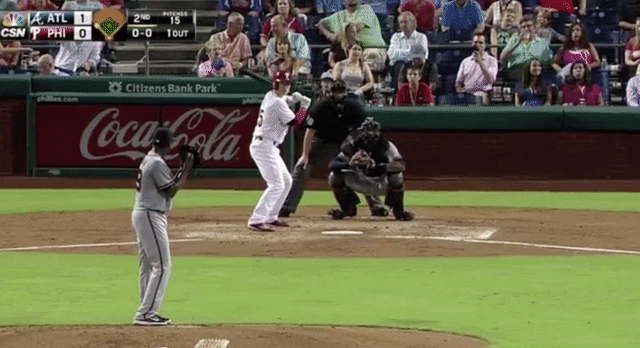
Change-up
Year Usage Vel SwK Contact% ==== ===== ==== ===== ======== 2013 5% 82.7 14.3% 64.3% 2014 9% 82.3 10.1% 79.9% 2015 8% 83.4 11.2% 79.3% 2016 8% 83.0 5.9% 88.6%
Like the four-seamer, Teheran's change-up is missing fewer bats, as SwK has plummeted in 2016. He continues to use the change-up sparingly, but the near-10 mph difference between change-up and fastball suggests the pitch still has potential. The problem has been location—hitters are making more contact off Teheran's change-up because he's leaving it in the zone. Teheran's pitch location on the change-up highlights how often he's done so this season vs. 2013-15. From Fangraphs.com (NOTE: these zone plots are from the pitcher's viewpoint, as opposed to the slider plot above):
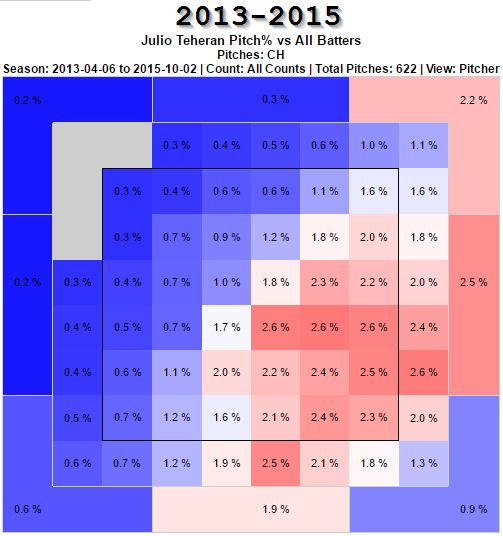
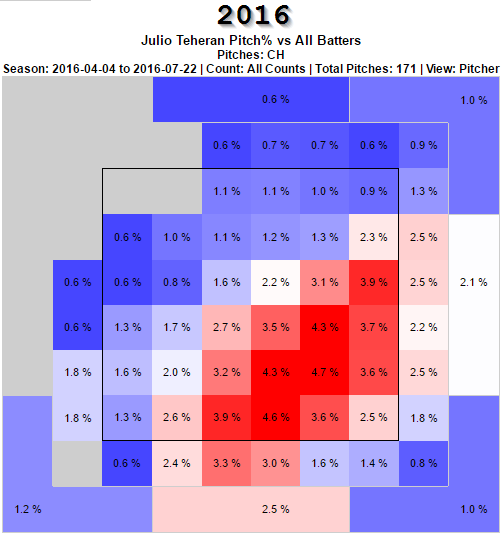
Though Teheran's changeup was referred to as a "knockout" pitch in our May 2011 call-up report, it's not a pitch you typically want to leave in the zone. If Teheran can keep his changeup out of the zone and force hitters to chase, we could see SwK revert to 2013-15 levels.
Outpitching his skills, consistently
As we noted in the initial BPI scan, Teheran’s xERA sits a full run higher than his surface ERA. While this typically leads to a swift correction, gaps like this have been commonplace for Teheran, as he's significantly outpitched xERA throughout his career:
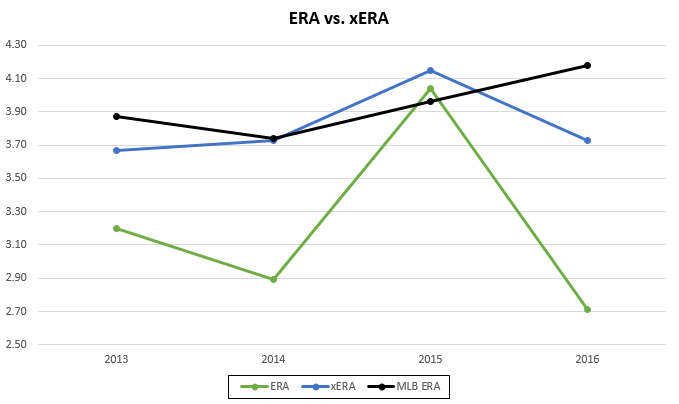
While xERA has long shown to be a strong estimator for a pitcher’s surface ERA, there have always been cases where certain pitchers can consistently outpitch their skills. Extreme fly ball pitchers (Jered Weaver, Héctor Santiago, Chris Young), knuckleballers, (R.A. Dickey), pop-up inducers (Marco Estrada), and super-humans (Clayton Kershaw) are all examples of pitchers who have consistently beaten their xERA.
Is Teheran one of these guys? Let's look at two main drivers of pitching luck: H% and S%.
Hit Rate (H%)
We’ll first look to some factors affecting Teheran’s hit rate—batted ball trajectory and quality of contact:
Year (H%) GB/LD/FB IFFB%* HH% EV ========= ======== ====== === ==== 2013 (30) 38/21/41 5.1% 31 -- 2014 (28) 35/21/44 4.7% 30 -- 2015 (29) 40/24/36 3.5% 31 89.4 2016 (24) 40/19/41 3.4% 35 89.4 *Infield fly ball rate (league average: ~3%)
- Teheran gives up more fly balls than average. He's not an extreme FBer, but the fly balls are likely keeping his H% down.
- The exit velocity off Teheran remains near league average, while our hard-hit rate metric (HH%) suggests he’s actually giving up more hard contact in 2016.
- Pop-ups (IFFB%) can essentially be treated as automatic outs, but Teheran's inducing fewer of those throughout his career. Fewer automatic outs off the bat should nudge H% higher; all else being equal.
Teheran's FB tilt suggests he'll be able to keep H% in favorable territory, but he's not adept at limiting hard contact and he's generating fewer pop-ups. Look for 2016's H% to head back to the upper-20s shortly, which will have an impact on ERA and WHIP.
Strand Rate (S%)
Another factor driving the gap between Teheran’s ERA and xERA has been a high strand rate (S%), which has held firm in the upper-70s (MLB average is roughly 72%). We typically expect S% to tend back towards league average, but let’s look at Teheran’s skills with runners on to see if something else is happening:
WITH RUNNERS ON
Year (S%) IP Ctl Dom Cmd H% GB% hr/f HH% BPV
========== == === === === == === ==== === ===
2013 (78%) 75 2.7 7.6 2.8 26 39 11% 30 81
2014 (77%) 85 1.8 7.3 4.0 27 34 11% 31 95
2015 (73%) 82 3.7 7.0 1.9 31 34 18% 32 38
2016 (79%) 44 2.9 8.0 2.8 23 46 14% 38 90
A spike in ground balls this year has likely helped fuel more double plays, but Teheran's base skills with runners on (Cmd, BPV) have been league average. He's actually giving up more hard-hit balls this season despite a career-high S%.
There's not much here to suggest Teheran can maintain 2016's fortunate H% and S% over a longer span. He may still be able to outpitch his peripherals, but not quite to this magnitude.
Has he solved lefties?
A final piece of the Teheran puzzle involves his inconsistent performance vs. LHB from season to season. On the surface, he’s improved greatly against lefties in 2016, as they're slashing just .205/.286./.381 off Teheran this year. Would the skills agree?
vL PA oOBP oSLG HR K% BB% Cmd H%/S% ==== === ==== ==== == == === === ===== 2013 381 .340 .483 14 14 7 2.7 33/80 2014 457 .292 .395 13 13 7 2.8 27/76 2015 422 .387 .507 18 15 11 1.4 32/75 2016 241 .286 .381 9 16 9 1.9 21/80
Though Teheran has seemingly held lefties in check this season, the underlying BPIs beg to differ. Teheran’s K% has remained stagnant and well below league average (21%), while Cmd has dropped since 2015. Further, we can mostly pin Teheran’s surface “gains” on a miniscule h%; one that he’s never displayed in the past. Ditto for a fortunate S%.
Conclusion
So, have we already seen the best of Julio Teheran?
He’s just 25, but the case could certainly be made. The velocity on Teheran’s go-to pitch, the four-seam fastball, has dropped from the mid-90s as a prospect to just 92 mph this season, and the effects can be seen in fewer swinging strikes and more line drives. He's grabbing too much of the zone with his change-up, there's little to support the magnitude of 2016's H%/S% fortune, and his surface gains vs. LHB don't appear to be sustainable.
However, it’s not all doom and gloom for Teheran. His excellent control remains a major asset, his slider is an increasingly used weapon that misses plenty of bats, and he’s been able to outpitch his peripherals—while not to 2016’s degree—throughout his career. The change-up could develop into a legit offering if he can regain control of it, and he still has a GB%-generator in his two-seam fastball when needed.
Overall, this isn't a profile of the #1 starter many thought Teheran would be, but the floor is high. Keeper league owners would be wise to talk up Teheran's multiple sub-3.00 ERA seasons and prospect pedigree, as it could return an ace-level haul for what looks to be a decent #2 pitcher going forward.




